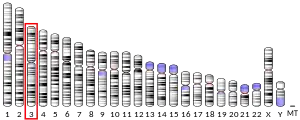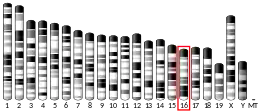DGKG
Diacylglycerol kinase gamma is an enzyme that in humans is encoded by the DGKG gene.[5][6]
| DGKG | |||||||||||||||||||||||||||||||||||||||||||||||||||
|---|---|---|---|---|---|---|---|---|---|---|---|---|---|---|---|---|---|---|---|---|---|---|---|---|---|---|---|---|---|---|---|---|---|---|---|---|---|---|---|---|---|---|---|---|---|---|---|---|---|---|---|
| Identifiers | |||||||||||||||||||||||||||||||||||||||||||||||||||
| Aliases | DGKG, DAGK3, DGK-GAMMA, diacylglycerol kinase gamma | ||||||||||||||||||||||||||||||||||||||||||||||||||
| External IDs | OMIM: 601854 MGI: 105060 HomoloGene: 1029 GeneCards: DGKG | ||||||||||||||||||||||||||||||||||||||||||||||||||
| |||||||||||||||||||||||||||||||||||||||||||||||||||
| |||||||||||||||||||||||||||||||||||||||||||||||||||
| |||||||||||||||||||||||||||||||||||||||||||||||||||
| |||||||||||||||||||||||||||||||||||||||||||||||||||
| |||||||||||||||||||||||||||||||||||||||||||||||||||
| Wikidata | |||||||||||||||||||||||||||||||||||||||||||||||||||
| |||||||||||||||||||||||||||||||||||||||||||||||||||
This gene encodes an enzyme that is a member of the type I subfamily of diacylglycerol kinases, which are involved in lipid metabolism. These enzymes generate phosphatidic acid by catalyzing the phosphorylation of diacylglycerol, a fundamental lipid second messenger that activates numerous proteins, including protein kinase C isoforms, Ras guanyl nucleotide-releasing proteins and some transient receptor potential channels. Diacylglycerol kinase gamma has been implicated in cell cycle regulation and in the negative regulation of macrophage differentiation in leukemia cells. Multiple transcript variants encoding different isoforms have been found for this gene.[6]
References
- GRCh38: Ensembl release 89: ENSG00000058866 - Ensembl, May 2017
- GRCm38: Ensembl release 89: ENSMUSG00000022861 - Ensembl, May 2017
- "Human PubMed Reference:". National Center for Biotechnology Information, U.S. National Library of Medicine.
- "Mouse PubMed Reference:". National Center for Biotechnology Information, U.S. National Library of Medicine.
- Kai M, Sakane F, Imai S, Wada I, Kanoh H (Aug 1994). "Molecular cloning of a diacylglycerol kinase isozyme predominantly expressed in human retina with a truncated and inactive enzyme expression in most other human cells". J Biol Chem. 269 (28): 18492–8. doi:10.1016/S0021-9258(17)32336-0. PMID 8034597.
- "Entrez Gene: DGKG diacylglycerol kinase, gamma 90kDa".
Further reading
- Brose N, Betz A, Wegmeyer H (2004). "Divergent and convergent signaling by the diacylglycerol second messenger pathway in mammals". Curr. Opin. Neurobiol. 14 (3): 328–40. doi:10.1016/j.conb.2004.05.006. PMID 15194113. S2CID 7070625.
- Luo B, Regier DS, Prescott SM, Topham MK (2005). "Diacylglycerol kinases". Cell. Signal. 16 (9): 983–9. doi:10.1016/j.cellsig.2004.03.016. PMID 15212759.
- Topham MK (2006). "Signaling roles of diacylglycerol kinases". J. Cell. Biochem. 97 (3): 474–84. doi:10.1002/jcb.20704. PMID 16288460. S2CID 38850368.
- Bonaldo MF, Lennon G, Soares MB (1997). "Normalization and subtraction: two approaches to facilitate gene discovery". Genome Res. 6 (9): 791–806. doi:10.1101/gr.6.9.791. PMID 8889548.
- Yamada K, Sakane F, Matsushima N, Kanoh H (1997). "EF-hand motifs of alpha, beta and gamma isoforms of diacylglycerol kinase bind calcium with different affinities and conformational changes". Biochem. J. 321. ( Pt 1): 59–64. doi:10.1042/bj3210059. PMC 1218036. PMID 9003401.
- Stöhr H, Klein J, Gehrig A, et al. (1999). "Mapping and genomic characterization of the gene encoding diacylglycerol kinase gamma (DAGK3): assessment of its role in dominant optic atrophy (OPA1)". Hum. Genet. 104 (1): 99–105. doi:10.1007/s004390050917. PMID 10071200. S2CID 19248400.
- Strausberg RL, Feingold EA, Grouse LH, et al. (2003). "Generation and initial analysis of more than 15,000 full-length human and mouse cDNA sequences". Proc. Natl. Acad. Sci. U.S.A. 99 (26): 16899–903. Bibcode:2002PNAS...9916899M. doi:10.1073/pnas.242603899. PMC 139241. PMID 12477932.
- Yamada K, Sakane F, Imai S, et al. (2003). "Regulatory role of diacylglycerol kinase gamma in macrophage differentiation of leukemia cells". Biochem. Biophys. Res. Commun. 305 (1): 101–7. doi:10.1016/S0006-291X(03)00713-7. PMID 12732202.
- Oyaizu K, Kantarci A, Maeda H, et al. (2003). "Identification of mRNAs for the various diacylglycerol kinase isoforms in neutrophils from patients with localized aggressive periodontitis". J. Periodont. Res. 38 (5): 488–95. doi:10.1034/j.1600-0765.2003.00680.x. PMID 12941073.
- Tsushima S, Kai M, Yamada K, et al. (2004). "Diacylglycerol kinase gamma serves as an upstream suppressor of Rac1 and lamellipodium formation". J. Biol. Chem. 279 (27): 28603–13. doi:10.1074/jbc.M314031200. PMID 15102830.
- Filosto M, Mancuso M, Tomelleri G, et al. (2004). "Hepato-cerebral syndrome: genetic and pathological studies in an infant with a dGK mutation". Acta Neuropathol. 108 (2): 168–71. doi:10.1007/s00401-004-0872-9. PMID 15150663. S2CID 31732164.
- Batista EL, Warbington M, Badwey JA, Van Dyke TE (2005). "Differentiation of HL-60 cells to granulocytes involves regulation of select diacylglycerol kinases (DGKs)". J. Cell. Biochem. 94 (4): 774–93. doi:10.1002/jcb.20356. PMID 15578578. S2CID 114877.
- Matsubara T, Shirai Y, Miyasaka K, et al. (2006). "Nuclear transportation of diacylglycerol kinase gamma and its possible function in the nucleus". J. Biol. Chem. 281 (10): 6152–64. doi:10.1074/jbc.M509873200. PMID 16407189.
- Yamaguchi Y, Shirai Y, Matsubara T, et al. (2006). "Phosphorylation and up-regulation of diacylglycerol kinase gamma via its interaction with protein kinase C gamma". J. Biol. Chem. 281 (42): 31627–37. doi:10.1074/jbc.M606992200. PMID 16905533.




